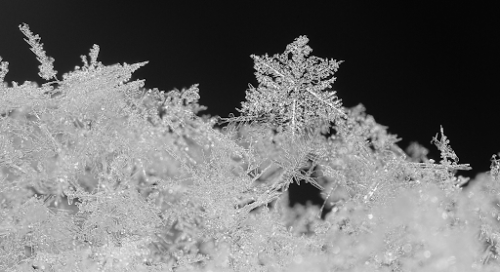Image courtesy of Flickr.
Freezing: a simple phase transition with a surprisingly complex set of mechanisms. Researchers use freezing dynamics to study the crystallization of various materials, but not all kinds of freezing are mechanistically understood. Graduate student Sarwar Hussain and professor Amir Haji-Akbari in the Department of Chemical and Environmental Engineering at Yale recently simulated contact freezing to unravel its unique mechanism.
In contact freezing, a water droplet that is supercooled—below freezing temperature but still liquid—collides with an external particle that promotes nucleation, the initiating step in the process of freezing. This results in unusually rapid ice formation. However, why exactly freezing proceeds so quickly remains unclear. Previous studies have suggested two key points. First, the rate of contact freezing is related to the liquid’s tendency to surface freeze—that is, to rapidly freeze its surface relative to the interior. Second, the nucleating particle doesn’t necessarily have to directly disrupt the liquid-vapor interface to increase the freezing (nucleation) rate.
The researchers’ results ruled out the prevailing theories on its mechanism. “[These findings] were not necessarily explained by the previous mechanisms which said that there has to be some sort of mechanical disturbance in the free interface between the liquid and the vapor for the increased freezing rate to take place,” Hussain said.
Further experiments into this nucleation mechanism are hindered by the limits of technology. Freezing events occur on the nanosecond timescale and create ice nuclei containing only hundreds to thousands of molecules. They cannot be observed with sufficient resolution, so the mystery of high nucleation rates during contact freezing is difficult to approach experimentally.
What can’t yet be accomplished in a physical lab, though, can now be done computationally. Two major advancements allowed for the accurate simulation of contact freezing. The first was the mW model, a water-like tetrahedral model liquid that enables rapid simulation while still considering interactions like hydrogen bonding. The second was the development of jumpy forward flux sampling, a novel sampling technique conceptualized by Haji-Akbari to address the shortcomings of the original forward flux sampling method. The original method could be used to estimate the likelihood of freezing events progressing toward complete freezing, but Haji-Akbari’s version accounts for the jumpiness of freezing progression caused by the coagulation of ice particles. “If you do not take into account these jumps, you can underestimate the nucleation rate by several orders of magnitude,” Haji-Akbari said.
With these advancements, the researchers were able to simulate the nanoscale dynamics of contact freezing for two mW-based liquids, one that had a surface freezing propensity and one that did not. By simulating supported nanofilms of the liquids, they were able to exclusively investigate the effect of the proximity of the nucleating particle to the vapor-liquid interface on the nucleation rate.
From their simulations, they observed that only the surface freezing liquid’s nucleation rate was affected by proximity to the nucleating particle, increasing the nucleation rate by orders of magnitude. Moreover, they discovered that in such a case, freezing proceeds through the formation of hourglass-shaped nuclei, a unique property that mechanistically explains the increased nucleation rate. Compared to the spherical cap-shaped nuclei of classical models, hourglass-shaped nuclei have a smaller surface area exposed to the liquid. According to classical nucleation theory, the smaller liquid-exposed surface area lowers the nucleation barrier, allowing nucleation to proceed faster.
Their findings have implications for understanding contact freezing of water in the atmosphere, a phenomenon important for predicting weather patterns. These results support the theory that water may be capable of surface freezing, giving it access to rapid nucleation through contact freezing. However, the authors also note that other agents in the atmosphere may also contribute to nucleation rate, making it difficult to conclude that the proximity effect of surface freezing liquids is necessarily the main cause for atmospheric nucleation rates.
More broadly, their discovery of this non-classical nucleation mechanism provides a roadmap to study other non-classical processes. For example, scientists may investigate nucleation in the vicinity of surfaces with different ice-forming properties, such as a protein with hydrophilic and hydrophobic patches. “The question is, if you put that protein inside supercooled water, what will happen? How will the critical nucleus look like, and how will the rate be sensitive to temperature, for example? These are all questions that our work gives a good conceptual framework to pursue,” Haji-Akbari said.
References:
Hussain, S., & Haji-Akbari, A. (2021). Role of Nanoscale Interfacial Proximity in Contact Freezing in Water. Journal of the American Chemical Society, 143(5), 2272–2284. https://doi.org/10.1021/jacs.0c10663

